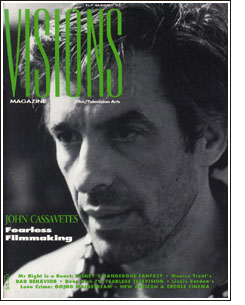 In
the end, Cassavetes said that he agreed to do the film largely as
a favor
to Rowlands, who relished the idea of playing a larger-than-life role.
The role deeply appealed to her. It tapped into a side of her that
captured
the way she sometimes thought of herself – the "sexy but tough
woman who doesn't really need a man" personality type that described
many
of the
actresses she had idolized over the years. Or one might say that Cassavetes
was having fun with her love for Marlene Dietrich (whom Gloria resembles
in many subtle ways).
In
the end, Cassavetes said that he agreed to do the film largely as
a favor
to Rowlands, who relished the idea of playing a larger-than-life role.
The role deeply appealed to her. It tapped into a side of her that
captured
the way she sometimes thought of herself – the "sexy but tough
woman who doesn't really need a man" personality type that described
many
of the
actresses she had idolized over the years. Or one might say that Cassavetes
was having fun with her love for Marlene Dietrich (whom Gloria resembles
in many subtle ways).
Though she really wanted to do it, she doesn't go about this very easily, you know. After the picture was written and the deal was made, she said, "Maybe you ought to get someone else." [Laughs.] Which is always maddening. On every film that we've ever made, she has enormous trepidations before she goes out and acts, but it's not because she can't act, but because she doesn't know whether she's capable of speaking for a bunch of women who are childless, and she wants to represent them truthfully. She doesn't want to represent them as caricatures, she wants to represent the people she's playing with some authenticity as to what they are feeling, what they would feel in a certain circumstance and in a way that not many actresses do. She's an artist. And her holdbacks are her pain. I mean, she went through a tremendous amount of pain thinking she's not good enough to play these things. Once she starts going she forgets "I'm not good enough" and the scenes hold her in check and she just keeps on going as long as she can.
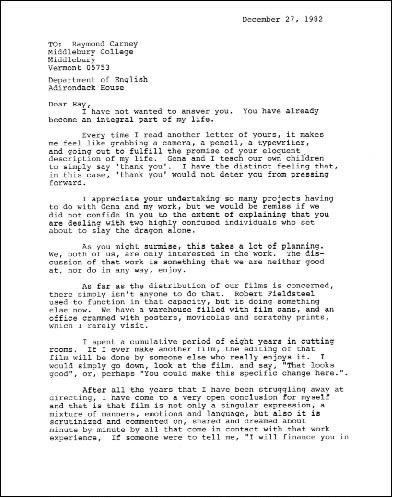 Cassavetes
was always in awe of what Rowlands could do with a script – even a weak
one.
Cassavetes
was always in awe of what Rowlands could do with a script – even a weak
one.
Gena is subtle, delicate. She's a miracle. She's straight. She believes in what she believes in. She's capable of anything. It's only because of Gena's enormous capacity to perform that we have a movie, because a lot of people would be a little bit too thin to work on it. Gena is a very interesting woman and for my money the best player that is around. She can just play. Give her anything and she'll always be creative. She doesn't try to make it different – she just is – because the way she thinks is different from the way most actors think. She goes in and she says, "Who do I like on this picture? What characters do I like, what characters am I so-so about?" I picked up her script once and I saw all these notes, all about what reaction she had to the various people both in the production and the story. It was very personal to her, and I felt very guilty that I'd snooped. Then I watched her work. She sets the initial premise and follows the script very completely. Very rarely will she improvise, though she does in her head and in her personal thoughts. Everybody else is going boom! boom! boom!, but Gena is very dedicated and pure. She doesn't care if it's cinematic, doesn't care where the camera is, doesn't care if she looks good – doesn't care about anything except that you believe her. She caught the rhythm of that woman living a life she'd never seen. When she's ready to kill, I'm amazed at how coldly she does it.
Cassavetes' father, to whom he was very close, died on 26 April 1979, during the final weeks of preparations to shoot, which possibly contributed to the film's autumnal feel and its striking emphasis on death. Three weeks were reserved for rehearsals. Shooting began at the former Concourse Plaza Hotel on 161st Street in the South Bronx, which was the set for the seedy apartment building at the beginning of the film. In the 1960s, it had become a home for welfare families, but it had been abandoned for four years at the point Cassavetes found it. An apartment house at 800 Riverside Drive (at 158th Street) served as the location for three of the nice apartments: Gloria's sister's place; the final hotel room Phil waits in; and mob leader Tony Tanzini's headquarters. Cassavetes loved the history both locations wore on their walls and had to struggle to keep Rene D'Auriac and the Columbia set-design crew from cleaning them up or retouching the graffiti on the Concourse Plaza.
In the beginning, I had to instruct them in bad taste, but now they're beginning to revel in it.
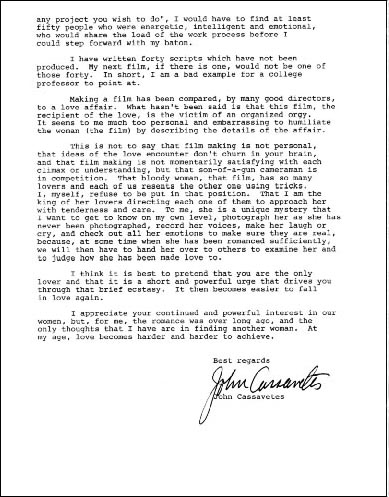 For the outdoor shots,
Cassavetes deliberately picked non-glamorized, non-touristy sections
of the city
to avoid the "Woody Allen movie" feeling.
For the outdoor shots,
Cassavetes deliberately picked non-glamorized, non-touristy sections
of the city
to avoid the "Woody Allen movie" feeling.
I love New York! I grew up there, and it seemed to me that all the pictures that are made about New York never concentrate on neighbor hoods. And New York to me is comprised of a series of neighborhoods. But I didn't want people to just say, "'OK. Now we're here. Now we're on 57th Street. Now we're on 58th Street." It was very important not to make the scenery be the center of attention, because, I don't know, I just feel there should be some more respect given to life than to the making of a film.
Producer Sam Shaw helped to select the locations. Since he had been friends with Romare Bearden and written a book about his work, he suggested using his watercolors for the title cards. (Shaw had a lot of input into the artwork used in all of Cassavetes' films and a couple of years before had provided the photographs that were used in Marty and Virginia's apartment in Opening Night.)
As part of his effort to break away from Hollywood clichés, Cassavetes and Shaw rounded up actual gangsters and various street-people for the scene in Tony Tanzini's apartment. Cassavetes solicited their opinion about whether this was the way things would really happen. The man Gloria shoots on her way to the elevator, for example, was an actual professional hit man, with fifteen years' experience, who got into an argument with Cassavetes about how the scene would have really taken place if he were running things.
The aspect of the film that came in for the most criticism from reviewers was Juan Adames' performance. They came in apparently expecting him to be cute and cuddly in the Little Miss Marker mode. When he wasn't, they judged that Cassavetes had failed. What they overlooked was that Cassavetes deliberately worked hard to avoid sentimentality (of which the Sidney Lumet/Sharon Stone remake is guilty).
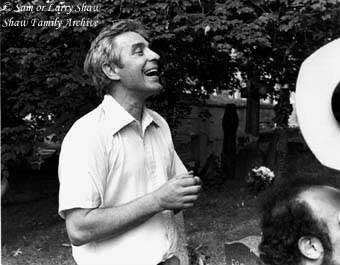 The kid is neither sympathetic
nor non-sympathetic. He's just a kid. He reminds me of me, constantly
in shock, reacting to this unfathomable environment. He was always full
of excitement and wonderment as to what he was doing, trying to comprehend
this fathomless story of a family being wiped out.
The kid is neither sympathetic
nor non-sympathetic. He's just a kid. He reminds me of me, constantly
in shock, reacting to this unfathomable environment. He was always full
of excitement and wonderment as to what he was doing, trying to comprehend
this fathomless story of a family being wiped out.
To add to the toughness of the performance, Gena Rowlands didn't come out of character between takes and was as cool to Adames when they weren't filming as when they were. She felt that if she treated him any differently on the set than her character was in the movie, it would only confuse the boy and potentially spoil their scenes. Cassavetes endorsed her decision (and in fact wanted her to be even tougher and harder on him than she chose to be). An aspect of the film that Cassavetes may not have even been conscious of was that Phil, the midget macho man, was an emotional, if not a literal, self-portrait of the artist, and Rowlands' treatment of the pint-sized Puerto Rican tough-guy was a comical rendition of her real-life relationship with her swaggering husband.
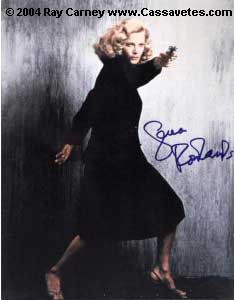 She and the kid found an amazing
restraint. Most people today say, "Tell me you like me, tell me you
love
me." People need that reassurance, that confirmation of things that should
be self-evident. But these characters go on the basis that there are
certain
emotions and rules that go beyond words and assurances. They just know.
I like that part of the movie. The kid is Puerto Rican. The woman
is a
blonde of a type who might not ordinarily think a Hispanic was the highest
member of society. Even when they're thrown together, they don't pretend
to care about each other because it's fashionable. So at the end, when
they do care about each other, it's because of their personal trust
and
regard. And that's a beautiful thing to see.
She and the kid found an amazing
restraint. Most people today say, "Tell me you like me, tell me you
love
me." People need that reassurance, that confirmation of things that should
be self-evident. But these characters go on the basis that there are
certain
emotions and rules that go beyond words and assurances. They just know.
I like that part of the movie. The kid is Puerto Rican. The woman
is a
blonde of a type who might not ordinarily think a Hispanic was the highest
member of society. Even when they're thrown together, they don't pretend
to care about each other because it's fashionable. So at the end, when
they do care about each other, it's because of their personal trust
and
regard. And that's a beautiful thing to see.
The main interest of the film, for Cassavetes, was the character of Gloria.
It was about a woman who beyond her control stood up for a kid whom she wanted nothing to do with. Gena's character was of a very simple person that loved her life and having to give it up for a Puerto Rican kid in New York City; it's like if I meet somebody and they say, "Hey man, can you help me? I'm in a lot of trouble, and I'm going to be killed." It's one thing to be killed. But it's another thing to give up everything that you own in life, all your friends, your whole way of life. So I think this woman gives up her whole way of life, and she does it in such a fashion that you believe her, and that's basically the picture. If that works, then I think the picture works.
 Gloria celebrates the
coming together of a woman who neither likes nor understands children
and a boy who believes he's man enough to stand on his own. There's
a
lot of pain connected with raising children in today's world. It's
considered a big holdback for a woman. So a lot of women have developed
a distrust
of children. I wanted to tell women that they don't have to like children
– but there's still something deep in them that relates to children,
and
this separates them from men in a good way. This inner understanding
of kids is something very deep and instinctive. In a way, it's the
other
side of insanity. But we had to be careful how we evoked this in the
movie. We avoided anything like a traditional
mother-son relationship. Gloria doesn't know why she's doing any of
these things. She's lost by it, and
that's the way I feel. I'm lost by life. I don't know anything about
life. If I make a movie, I don't even understand why I'm making the
movie. I
just know that there's something there. Later on, we all get to know
what it's about through the opinions of others.
Gloria celebrates the
coming together of a woman who neither likes nor understands children
and a boy who believes he's man enough to stand on his own. There's
a
lot of pain connected with raising children in today's world. It's
considered a big holdback for a woman. So a lot of women have developed
a distrust
of children. I wanted to tell women that they don't have to like children
– but there's still something deep in them that relates to children,
and
this separates them from men in a good way. This inner understanding
of kids is something very deep and instinctive. In a way, it's the
other
side of insanity. But we had to be careful how we evoked this in the
movie. We avoided anything like a traditional
mother-son relationship. Gloria doesn't know why she's doing any of
these things. She's lost by it, and
that's the way I feel. I'm lost by life. I don't know anything about
life. If I make a movie, I don't even understand why I'm making the
movie. I
just know that there's something there. Later on, we all get to know
what it's about through the opinions of others.
***
Cassavetes' responses to common critical objections to the film:
–On why Buck Henry didn't
pack and leave earlier.
You never can leave early. You always think now I'm gonna run out
and get out of town, but if you have a wife, you understand that she has
to get ready, and if you have a child or two kids, then you realize that
they have to get ready. And if you have two kids and a grandmother, there's
an awful lot of packing to be done. So you can say let's go a million
times to your wife and family, and they're still going to be late.
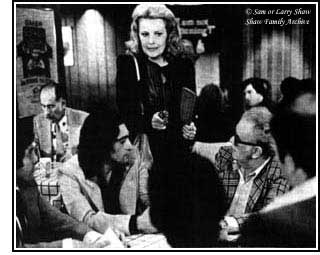 –On why the gangsters weren't
better organized:
–On why the gangsters weren't
better organized:
I consider gangsters to be the same as regular people, the only difference
is that they're willing to kill somebody. I don't consider gangsters anything
more than that except they have a deeper limit of what the tolerance of
the human spirit will allow. And I don't think they're smarter than anybody
else. I don't think they're smarter than I am.
–On why Gloria wasn't searched
before she met the boss.
I
think that's protocol. I think it's OK to blow away small mob figures,
guys that are trying to kill you, or trying to kill somebody involved
with you. But when you walk into the head Mafia guy's house, and they're
like ten people in the room – and this woman had been the head
man's mistress – I don't think there's any doubt that she wouldn't
be searched,
because no
one in the world would ever expect her to try to walk out of that place.
It's such a come-down in position to search somebody. Can you imagine
the Secretary of State of the United States going to Russia to see the
top Commissar and being searched? You wouldn't be searched. Even with
them, there's some kind of politeness.
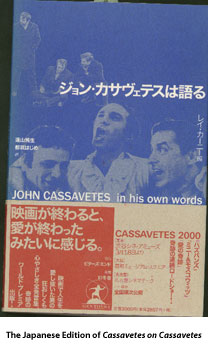 –On why the gangsters didn't
just shoot Gloria when she came in.
–On why the gangsters didn't
just shoot Gloria when she came in.
It's not a bunch of guys that the minute a woman gives herself up,
that they take her off and put her in cement and throw her in a river.
[It's] difficult for the head guy, who has bought her jewels, as he says,
and he's gone to bed with her, and who's lived with her, to just pull
the trigger. It's never easy. I think that it's only in movies that it's
easy. The hell with it. And I like to deal with people who have a little
bit more feeling than just the stereotype – [unlike other movies
where it's] the kiss of death and then it's over with.
The end sequence, when the
Phil is praying beside the tombstone and Gloria gets out of the limo,
was originally in black-and-white.
I would say that fifty per cent of the people like it in black-and-white
and fifty per cent of the people like the color. And a lot of people
don't
like the ending no matter what happens! In honesty, I think the
ending is not as good as it could be. [I just did it that way] because
I really didn't want the kid to suffer. What kind of picture would it
be if at the end the kid went to pieces? I just didn't want to kill off
the person who had protected that boy.
Cassavetes always regarded
Gloria as a pot-boiler. Since it was his most "conventional,"
"Hollywood" movie, it was ironically appropriate
that American reviewers (including The New York Times' Vincent
Canby, who had panned Cassavetes' previous films), pronounced it his "finest work,"
but even with the reviewers' support, Gloria did only mediocre
business at the box office. Cassavetes, Rowlands, and Adames could not
come anywhere near the drawing power of Zeffirelli, Dunaway, and Schroder.
 It
was television fare as a screenplay, but handled by the actors to make
to better. It's an adult fairy tale. And I never pretended it was anything
else but fiction. I always thought I understood [it]. And I was bored
because I knew the answer to that picture the minute we began. And that's
why I could never be wildly enthusiastic about the picture – because
it's so simple. Whereas Husbands is not simple, whereas A Woman
Under the Influence is not simple, Opening Night is not simple.
You have to think about those pictures. The next picture we make will
be a
deep personal statement. I don't know if anyone will finance it. Fortunately,
[now] I have some money....
It
was television fare as a screenplay, but handled by the actors to make
to better. It's an adult fairy tale. And I never pretended it was anything
else but fiction. I always thought I understood [it]. And I was bored
because I knew the answer to that picture the minute we began. And that's
why I could never be wildly enthusiastic about the picture – because
it's so simple. Whereas Husbands is not simple, whereas A Woman
Under the Influence is not simple, Opening Night is not simple.
You have to think about those pictures. The next picture we make will
be a
deep personal statement. I don't know if anyone will finance it. Fortunately,
[now] I have some money....
This page only contains excerpts and selected passages from Ray Carney's writing about John Cassavetes. To obtain the complete text as well as the complete texts of many pieces about Cassavetes that are not included on the web site, click here.